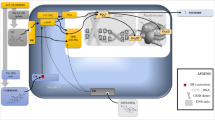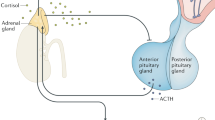Abstract
Stress, which is an adaptive response of the body, is controlled by the brain. The neuroendocrine system, in particular the hypothalamo–pituitary–adrenal axis (HPAA), is a key player in the stress response. A number of studies have confirmed an association between stress and neurodegenerative and mental diseases and the major role of HPAA dysfunction and cortisol excess in this association. Although many signaling pathways stimulated by HPAA have been discovered, there are many possibilities for switching between these signal transduction pathways and for combining them; numerous factors would determine the involvement of definite mechanisms in the stress response. An aberrant neurochemistry of stress vulnerability and the stress response is the essence of most (if not all) stress-related mental and neurologic diseases, with depressive states being prime example. The neurochemistry of depression is, in fact, the neurochemistry of an abnormal stress response. The stress response may have to be measured; important goals of translational studies include validation of animal models of depression and unification of physiological and biochemical indices of the stress response for comparative analysis of different models and data from depressive patients, as well as elaboration of valid indices of the stress response for patients. For these purposes, it is critical to non-invasively analyze biomaterials such as saliva and hair.
Similar content being viewed by others
Abbreviations
- ACTH:
-
adrenocorticotropic hormone
- CORT:
-
cortisol (corticosterone)
- CRH:
-
corticotropin-releasing hormone
- HPAA:
-
hypothalamo–pituitary–adrenal axis
- LS:
-
lymbic system
- PFC:
-
prefrontal cortex.
References
Cannon, W., Am. J. Med., 1935, vol. 189, pp. 1–14.
Selye, H., J. Clin. Endocrinol. Metab., 1946, vol. 6, pp. 117–230.
McEwen, B., Physiol. Rev., 2007, vol. 87, pp. 873–904.
McEwen, B.S. and Sapolsky, R.M., Curr. Opin. Neurobiol., 1995, vol. 5, pp. 205–216.
Baumann, N. and Turpin, J.C., Neurochem. Res., 2010, vol. 35, pp. 1875–1879.
Hauger, R.L., Risbrough, V., Oakley, R.H., Olivares-Reyes, J.A., and Dautzenberg, F.M., Ann. NY Acad. Sci., 2009, vol. 1179, pp. 120–143.
de Kloet, E.,R., Otte, C., Kumsta, R., Kok, L., Hillegers, M.H., Hasselmann, H., Kliegel, D., and Joëls, M., J. Neuroendocrinol., 2016, vol. 28, no. 8, doi 10.1111/jne.12379
Joseph, J.J. and Golden, S.H., Ann. NY Acad. Sci., 2017, vol. 1391, pp. 20–34.
Juruena, M.F., Epilepsy Behav., 2014, vol. 38, pp. 148–159.
Bosch, O.G., Seifritz, E., and Wetter, T.C., World J. Biol. Psychiatry, 2012, vol. 13, pp. 556–568.
Kiecolt-Glaser, J.K., Preacher, K.J., MacCallum, R.C., Atkinson, C., Malarkey, W.B., and Glaser, R., Proc. Natl. Acad. Sci. U.S.A., 2003, vol. 100, pp. 9090–9095.
Finnell, J.E. and Wood, S.K., Neurobiol. Stress, 2016, vol. 4, pp. 1–14.
Iwata, M., Ota, K.T., and Duman, R.S., Brain Behav. Immun., 2013, vol. 31, pp. 105–114.
Piskunov, A., Stepanichev, M., Tishkina, A., Novikova, M., Levshina, I., and Gulyaeva, N., Metab. Brain Dis., 2016, vol. 31, pp. 445–454.
Tishkina, A., Stepanichev, M., Kudryashova, I., Freiman, S., Onufriev, M., Lazareva, N., and Gulyaeva, N. Behav. Brain Res., 2016, vol. 304, pp. 1–10.
Gulyaeva, N.V., Biochemistry (Moscow), 2017, vol. 82, pp. 237–242.
Gulyaeva, N.V., Biochemistry (Moscow), 2017, vol. 82, pp. 301–307.
Tafet, G.E. and Nemeroff, C.B., Neuropsychiatry Clin. Neurosci., 2016, vol. 28, pp. 77–88.
Gold, P.W., Machado-Vieira, R., and Pavlatou, M.G., Neural Plast., 2015, vol. 2015, p. 581976.
Heim, C. and Binder, E.B., Exp. Neurol., 2012, vol. 233, pp. 102–111.
Grigoryan, G.A. and Gulyaeva, N.V., Zh. Vyssh. Nerv. Deyat. im. I.P. Pavlova, 2015, vol. 65, pp. 19–32.
Ross, J.A., Gliebus, G., and Van Bockstaele, E.J., Prog. Neuropsychopharmacol. Biol. Psychiatry, 2017, pii S0278-5846(16)30172-5
Hemmerle, A.M., Herman, J.P., and Seroogy, K.B., Exp. Neurol., 2012, vol. 233, pp. 79–86.
Aznar, S. and Knudsen, G.M., J. Alzheimers Dis., 2011, vol. 23, pp. 177–193.
Wolkowitz, O.M., Epel, E.S., Reus, V.I., and Mellon, S.H., Depress. Anxiety, 2010, vol. 27, pp. 327–338.
Grigoryan, G.A. and Gulyaeva, N.V., Zh. Vyssh. Nerv. Deyat. im. I.P. Pavlova, 2015, vol. 65, no. 6, pp. 643–660.
Stepanichev, M., Dygalo, N.N., Grigoryan, G., Shishkina, G.T., and Gulyaeva, N., Biomed. Res. Int., 2014, vol. 2014, p. 932757.
Stepanichev, M.Y., Tishkina, A.O., Novikova, M.R., Levshina, I.P., Freiman, S.V., Onufriev, M.V., Levchenko, O.A., Lazareva, N.A., and Gulyaeva, N.V., Acta Neurobiol. Exp. (Wars.), 2016, vol. 76, pp. 324–333.
Druzhkova, T.A., Pochigaeva, K.I., Guekht, A.B., and Gulyaeva N.V., Neurochem. J., 2015, vol. 9, pp. 315–318.
Pochigaeva, K., Druzhkova, T., Yakovlev, A., Onufriev, M., Grishkina, M., Chepelev, A., Guekht, A., and Gulyaeva, N., Metab. Brain Dis., 2017, vol. 32, pp. 577–583.
Author information
Authors and Affiliations
Corresponding author
Additional information
Original Russian Text © N.V. Gulyaeva, 2018, published in Neirokhimiya, 2018, Vol. 35, No. 2, pp. 111–114.
Rights and permissions
About this article
Cite this article
Gulyaeva, N.V. The Neurochemistry of Stress: the Chemistry of the Stress Response and Stress Vulnerability. Neurochem. J. 12, 117–120 (2018). https://doi.org/10.1134/S1819712418020058
Received:
Published:
Issue Date:
DOI: https://doi.org/10.1134/S1819712418020058




